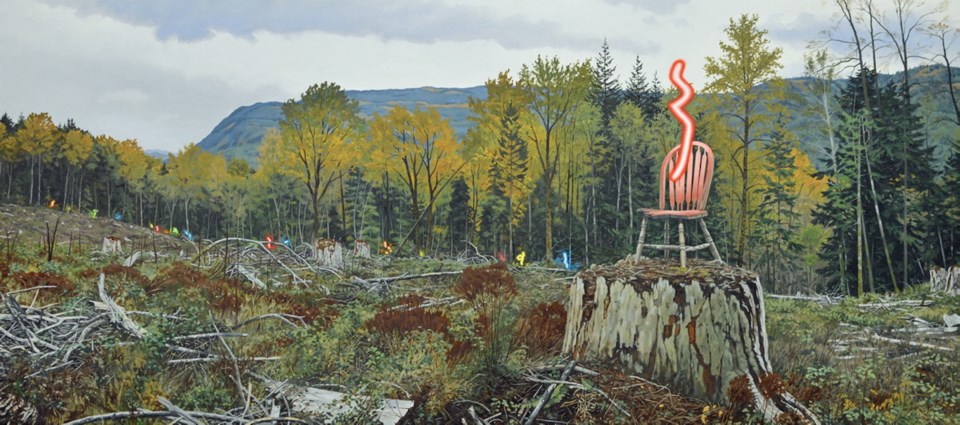 Winchester Galleries in Oak Bay has brought the work of five “emerging” artists to our attention.
Winchester Galleries in Oak Bay has brought the work of five “emerging” artists to our attention.
Carollyne Yardley is already well-known locally for her finely painted Squirrealism, in which glossy-eyed rodents sport all manner of costumes. Neil McClelland’s numinous landscapes of dystopian vacation realities were the subject of this column two months ago. Vicky Christou presents strands of extruded acrylic paint laid down in thick mats. Sean Mills offers sheets of transparent acrylic moulded into simple forms.
My attention was captured by the fifth member of this group, Jeremy Mangan. Mangan is a tall young man from Kent, Washington, now living in Tacoma. His roots there go deep, back to a great-great-grandfather who homesteaded along the Hood Canal. Mangan’s detailed canvases depict situations set in the local woods and waters so familiar to him.
His paintings are, at a glance, almost photo-realist and are accomplished with considerable skill. Yet each one has an element of the impossible, which interrupts and unsettles the familiar reality of it all. I spent an hour with the artist, getting to know him and coming to terms with what these “dispositions” might mean.
Mangan has always been artistic.
“I was the kid in school whose dinosaur was in three-quarter view with some shading,” he said with a chuckle. “There was a lot of artistic talent in my family, but the fine-art world never entered my perspective.” Thus his first training was as a commercial illustrator, but upon graduation he received a Fullbright fellowship to study in Munich, and the experience of studying at the Academy of Fine Arts there completely changed his direction.
“Things I did not see in suburban Kent, I was seeing every day,” he recalled. He had time to visit Paris, Italy, Greece, Spain. “It was a sea change, which opened and changed my paradigm.”
Subsequently, he did graduate studies at Hunter College in New York, living in that city for five years and eventually earning a living doing ice sculpture. New York was important to him, and he had the full experience, but concluded: “I’m not a New Yorker.”
Determined not to get lost carving ice 50 hours a week, he returned to base.
“I love being native,” he confessed. “I love where I’m from, my family and friends. I needed to trade money for time.” Now back in Tacoma, he revels in his “dream studio,” located above a fantastic café. “I’m glad to be home. It’s my lifeblood, it feeds my soul: the water and the colour.” His attachment to place is evident in every one of the five paintings on show.
We looked at his Lenticular Cloud, a giant sunset skyscape rising over a distant Mount Rainier. In the foreground is an enormous and improbable pile of chopped wood. There is always a trace of human presence in his landscapes, “but it’s not an environmental statement,” as he was quick to point out.
The next painting is set in a forest glade like Goldstream. A rustic seat is provided for someone to sit and consider a giant mossy rock shaped like a bear skull. The shape is improbable, but possible.
I noted his skill in rendering the deep woods, and said some people consider such ability as merely “illustration,” a pejorative term.
“I don’t believe that,” Mangan stated. “Every two-dimensional visual representation is some sort of illustration.” With his rigorous conceptual grounding, he’s turned this skill into an asset.
“I want to portray, to render and make a believable a coherent single experience and image. That’s the magic,” he told me. “I like to reward the viewer.”
Rigorous contemporary studies were upended upon discovering a painting by Hans Holbein in a museum.
“When I discovered I could make the kind of work that I would want to see, my focus shifted, and it became more fun.” His goal is to create a singular visual experience, fully communicating without additional commentary.
The first painting of his series shows the tangled roots of a tree, clasping a pirate’s chest. It has been pried it open a little, and light bursts out. Through these paintings, an intrusion into the natural world is represented by light — more spirit than object.
One of the most effective paintings takes place in the slash and waste of a beautifully rendered clearcut. On a weathered stump in the centre, an old wooden chair acts as host to a hovering, buzzing blip of neon. Other blips hover on the margin of the clearing. These beings are some kind of life form. They seem to have a consciousness, and some sort of purpose and organization.
“They are strange, even to me,” Mangan admitted. His paintings flirt on the edge of possibility, occasionally going slightly beyond into the supernatural.
He cultivates the tension between the humorous and the melancholy.
“The interesting places are in the tensions,” Mangan explained. “When I hit that tone, that timbre of disposition, there is a satisfaction. That disposition is the thing I want to land on — neither romantic nor polemic.”
Finally, we consider his picture of a bonfire floating on the ocean.
“I do love campfires,” Mangan confessed. Logs heaped and burning with crackling embers, the little zips of sparks, and one burnt-out stick steaming away in the shallows — all are exquisitely rendered. But how well would a floating fire hold together, he wondered?
“My mind can’t solve it. Maybe just enjoy it,” the artist concluded.
And that’s just the way I like it.
Five, at Winchester Galleries, 2260 Oak Bay Ave., 250-595-2777, winchestergalleriesltd.com, until May 20.



